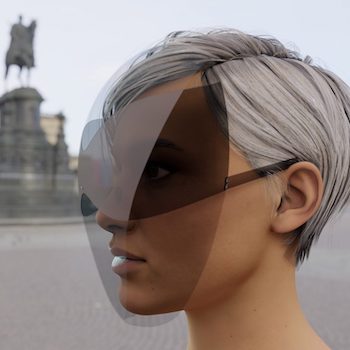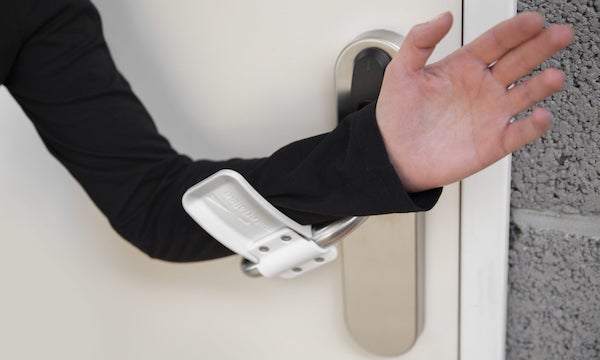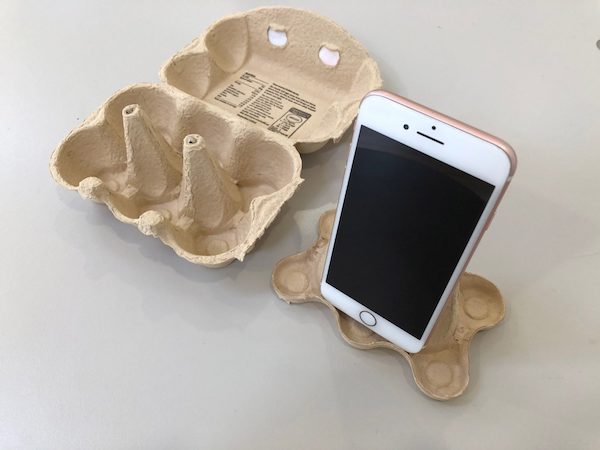Visual Arts Commentary: Life After Lockdown — Designs for Future Living After COVID-19
By Mark Favermann
These products are imaginative clues to what our “new normal” future will be like.

Fashionable Face Shield by Joe Doucet, Photo: Joe Doucet Partners.
This awful COVID-19 pandemic, made worse by a sorry lack of federal leadership, limited resources early on, and questionable distribution tactics, has unleashed our propensity for invention, particularly when it comes to Personal Protective Equipment (PPE) and medical monitoring devices. The call for innovation has not only gone out to reconstituted major manufacturers (like Ford, GM, Apple, etc.), but to individuals and smaller entities around the globe as well. Predictably, COVID-19 has inspired a growing number of products designed go beyond the protective basics.
These products are imaginative clues to what our “new normal” future will be like. Created primarily by architects and industrial designers, many of these objects — from protective devices to strategically safe spatial plans — suggest what life after lockdown will look like. Some of these projects are serious, others are impish; they all reflect notions of community, a spirit of shared humanity. Their creation is not limited to any particular geographical region or country; they are innovative solutions to a plague that encompasses the entire world.
In Italy, designers created a 3-D valve that could transform a snorkeling mask into a portable ventilator; in Ethiopia, an 18-year-old student invented a contactless electrical soap dispenser with a built-in sensor; and in Seattle, young brothers Joseph and Matthew Toles and friend Justin Ith created smartbands, which buzz if the wearer’s hand goes near his or her face. (If I wore one, it would be buzzing, annoyingly, all of the time.)
Door handles are considered nasty nests for contagion. A variety of products are being created to prevent people from touching things that others have already handled. Sometimes referred to as a hygienehook, this family of devices are designed to allow noncontact use of door handles, elevator buttons, keypads, etc. Fabricated in plastic and rather inexpensive, they come in a number of sizes, colors and even shapes.
There are a variety of no-hands “door pushers” in development as well. Designs spotlighting foot utilization are also being worked on, but at the moment these appear clunkier and more awkward-looking than the many hand devices available.

Paul Cocksedge, Here Comes the Sun Social Distancing Blanket. Downloadable Diagram, Image: Paul Cocksedge.
American designer Joe Doucet has created a very clever, and très elegant, face shield design. Unlike the current field of awkward shields, Doucet’s fashion-forward headgear features a curved see-through guard that’s set in front of a pair of sunglasses.
Another version of the face shield draws on a “George Jetson head in a bubble” aesthetic: iShield by Berlin-based Plastique Fantastique is made from a PVC sphere that can be purchased at art stores. Add-ons include a sunshade, a microphone, and, amusingly, a snorkel. The design is open-source — anyone can make it. Other designers have created one-size fits all face shields, including some (strange) macrame approaches.
Creative studio Production Club’s self-defeating (to me) concept for a visually flashy personal protective equipment suit is called the Micrashell. It is designed to make it possible for people to safely gather and party at performances and nightclubs during the pandemic. It seems more like a Clubbable Cosmonaut outfit — and how is it sanitized afterwards?
A variation on this idea is body pod protection. Invasion of the Pod People was a frightening horror movie. These protection pods don’t seem much friendlier. In February (yes February!), Chinese designer Sun Dayong came up with a body shield concept that would use UV light to sterilize itself. Ironically named Be a Bat Man, the outfit, worn like a backpack, is made from carbon fiber supports that are shaped like bat wings.
The pandemic has done away with handshakes and hugs, along with nudges and noogies. Now that businesses are starting to open up, isolation is giving way to social distancing, a gentler alternative. Architects and planners have started to develop spatial distancing layouts to assist commerce and food markets. Some of these proposed layouts and spatial configurations are quite clever. For instance, Vilnius in Lithuania has developed plans to turn the entire city into a huge open-air café: hard-hit bars and restaurants will be permitted to put their tables and chairs outdoors, as long as they abide by appropriate physical distancing and mask use.

Materialise’s Handless Door Opener. Photograph: Paolo Vergalito/Materialise.
On a lighter side, there’s the design for a social distance picnic blanket from London-based designer Paul Cocksedge. Called Here Comes the Sun, the blanket encourages people to “socialize safely and confidently” outdoors after lockdown restrictions have been lifted. The open-source design is composed of fabric in the shape of a large circle outline and four separate pieces of fabric cut into smaller circles placed around the outline at six feet apart.
A variation on this social distancing blueprint is C’entro, a circular ring that invites interaction without any plastic barriers. It was created by Italian design firm SBGA Biengini Ghirardelli at the request of Milan, which asked for ideas on how the city could reopen safely after over two months of lockdown. C’entro is a colorful modular fiberglass rod frame that snaps together to form a circle on the ground for up to two people. The horizontal spacers between each hoop mark the appropriate social distance.
After noticing the pain and discomfort that people felt (particularly in their arms) when using a smartphone during video calling, industrial designer Paul Priestman created a do-it-yourself stand from an egg box for video conferencing. His Zoom holder is open-source and just damn clever.

Egg Box Phone holder. Photo: Paul Priestman.
During the last three months, the world design community has directed its imagination, ingenuity, and skills to combat the problems generated by the spread of COVID-19. Some of these smart, adroit designs will no doubt help shape our world after lockdown has been lifted. Still, a warning: without post-pandemic legal protection/security for product liability, open-sourcing, and patent infringement, these innovations may well raise as many questions as they answer.
An urban designer and public artist, Mark Favermann has been deeply involved in branding, enhancing, and making more accessible parts of cities, sports venues, and key institutions. Also an award-winning public artist, he creates functional public art as civic design. The designer of the renovated Coolidge Corner Theatre, he is design consultant to the Massachusetts Downtown Initiative Program and, since 2002, he has been a design consultant to the Red Sox. Writing about urbanism, architecture, design and fine arts, Mark is Associate Editor of Arts Fuse.

Wonderful compendium, Mark. Just what we needed. You and your readers might also be interested seeing in more anti-Covid innovations, specifically aimed at protecting and supporting underdeveloped regions, by going to
https://www.techxlab.org/solutions/categories/covid19/. New ideas welcome!